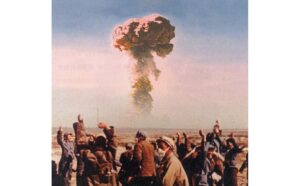China’s first atomic test on October 16, 1964, in Xinjiang. Mao wanted to prove the nation was a global power.
Fifty years ago yesterday, China detonated its first atomic bomb, joining the United States, Soviet Union, Britain and France as the only nuclear powers at the time.
The explosion in Lop Nur in eastern Xinjiang paved the way for the nation’s further development of nuclear weapons and its emergence as a world power, analysts say.
—
Project 596, (Miss Qiu (Chinese: 邱小姐, Qiū Xiǎojiě) as the callsign,[1] Chic-1 by the US intelligence agencies[2]) was the first nuclear weapons test conducted by the People’s Republic of China, detonated on 16 October 1964, at the Lop Nur test site. It was a uranium-235 implosion fission device made from weapons-grade uranium (U-235) enriched in a gaseous diffusion plant in Lanzhou.[3]
The atomic bomb was a part of China’s « Two Bombs, One Satellite » program. It had a yield of 22 kilotons, comparable to the Soviet Union’s first nuclear bomb RDS-1 in 1949 and the American Fat Man bomb dropped on Nagasaki, Japan in 1945.[4] With the test, China became the fifth nuclear power in the world and the first Asian nation to possess nuclear capability. This was the first of 45 successful nuclear tests China conducted between 1964 and 1996, all of which occurred at the Lop Nur test site.[5]


Satellite image of the Lop Nur test site taken by an American KH-4 Corona intelligence satellite on 20 October 1964, 4 days after the 596 test.
